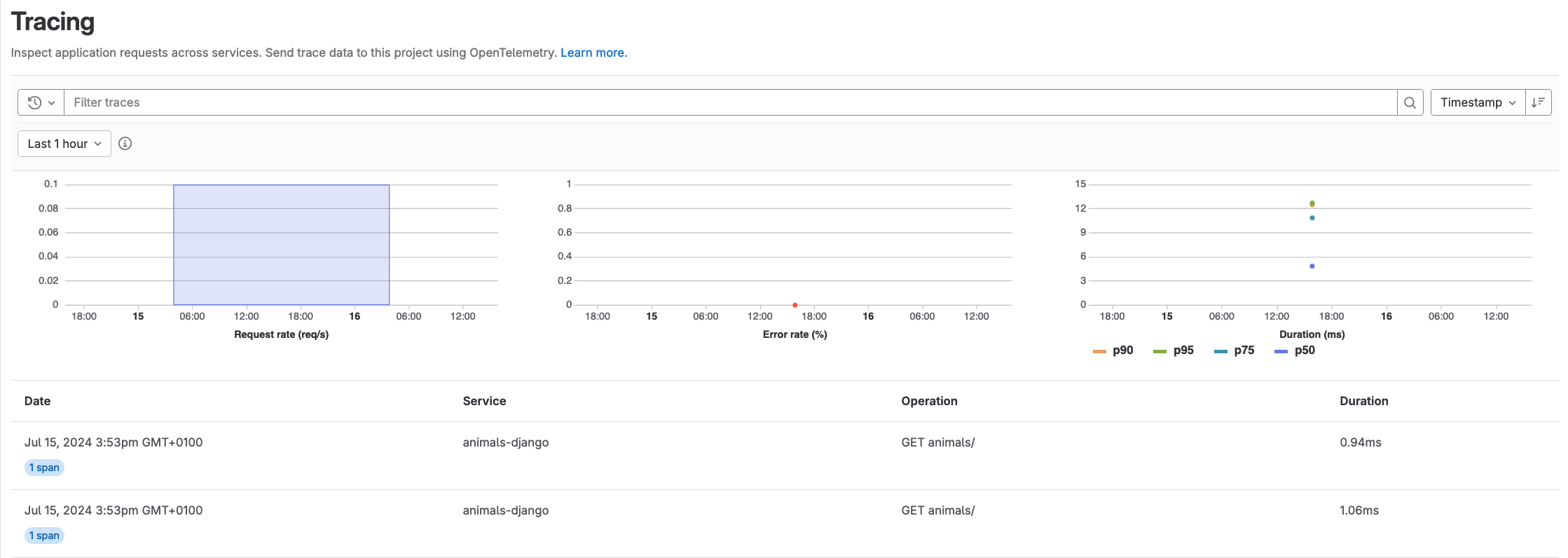6.7 KiB
stage, group, info
| stage | group | info |
|---|---|---|
| Monitor | Observability | To determine the technical writer assigned to the Stage/Group associated with this page, see https://handbook.gitlab.com/handbook/product/ux/technical-writing/#assignments |
Tutorial: Use GitLab Observability with a Django application
DETAILS: Tier: Ultimate Offering: GitLab.com Status: Beta
- Observability features introduced in GitLab 17.3 with a flag named
observability_features. Disabled by default.
FLAG: The availability of this feature is controlled by a feature flag. For more information, see the history. This feature is available for testing, but not ready for production use.
In this tutorial, we'll show you how to create, configure, instrument and monitor a Django application using GitLab observability features.
Before you begin
To follow along this tutorial, you should have:
- A GitLab Ultimate subscription for GitLab.com
- A local installation of Python 3 and Django (You can install it with
python -m pip install Django.) - Basic knowledge of Git and Python
- Basic knowledge of the core concepts of OpenTelemetry
Create a GitLab project
First, create a GitLab project and a corresponding access token.
This tutorial uses the project name animals.
- On the left sidebar, at the top, select Create new ({plus}) and New project/repository.
- Select Create blank project.
- Enter the project details.
- In the Project name field, enter
animals.
- In the Project name field, enter
- Select Create project.
- In the
animalsproject, on the left sidebar, select Settings > Access tokens. - Create an access token with the Owner role and the
read_apiandwrite_observabilityscopes. Store the token value somewhere safe—you'll need it later.
Create a Django application
To create an application:
-
From the command line, run the command:
python -m django startproject animals_app -
Check that the Django server is running correctly:
python manage.py runserver -
Ensure that the server is running correctly by visiting
http://localhost:8000. -
A Django projects contains multiple applications within a project. To create an application to manage our list of fake animals, run the command:
python manage.py startapp animals -
To create the initial view for the new
animalsapplication, in theanimals/views.pyfile add the following code:from django.http import HttpResponse def index(request): return HttpResponse("This is where the list of animals will be shown.") -
In
animals/urls.py, add the following code:from django.urls import path from . import views urlpatterns = [ path('', views.index, name='index'), ] -
Additionally, update the room
urls.pyto include theanimalsapp:path('animals/', include('animals.urls')) -
In
animals_app/settings.py, add the application:INSTALLED_APPS = [ ... 'animals.apps.AnimalsConfig', ] -
In
animals/models.py, create a model to define an animal:from django.db import models class Animal(models.Model): name = models.CharField(max_length=200) number_of_legs = models.IntegerField(default=2) dangerous = models.BooleanField(default=False) -
With the model defined, create a database migration. This will create a file that describes the changes to the database.
python manage.py makemigrations animals -
Run the newly created migration:
python manage.py migrate
Instrument the application with OpenTelemetry
-
Install the required dependencies:
pip install opentelemetry-api opentelemetry-sdk opentelemetry-exporter-otlp-proto-http -
Metrics and traces require different imports. In the
manage.pyfile, import the required modules:from opentelemetry.instrumentation.django import DjangoInstrumentor from opentelemetry.sdk.resources import SERVICE_NAME, Resource from opentelemetry import trace from opentelemetry.exporter.otlp.proto.http.trace_exporter import OTLPSpanExporter from opentelemetry.sdk.trace import TracerProvider from opentelemetry.sdk.trace.export import BatchSpanProcessor from opentelemetry import metrics from opentelemetry.exporter.otlp.proto.http.metric_exporter import OTLPMetricExporter from opentelemetry.sdk.metrics import MeterProvider from opentelemetry.sdk.metrics.export import PeriodicExportingMetricReader, ConsoleMetricExporter -
To instrument the application, in the
manage.pyfile add the following code (replacing{{PROJECT_ACCESS_TOKEN}},{{NAMESPACE_ID}}, and{{PROJECT_ID}}with the values from your project and root namespace):resource = Resource(attributes={ SERVICE_NAME: "animals-django" }) os.environ.setdefault('OTEL_EXPORTER_OTLP_HEADERS', "PRIVATE-TOKEN={{PROJECT_ACCESS_TOKEN}}") traceProvider = TracerProvider(resource=resource) processor = BatchSpanProcessor(OTLPSpanExporter(endpoint="https://observe.gitlab.com/v3/{{NAMESPACE_ID}}/{{PROJECT_ID}}/ingest/traces")) traceProvider.add_span_processor(processor) trace.set_tracer_provider(traceProvider) reader = PeriodicExportingMetricReader( OTLPMetricExporter(endpoint="https://observe.gitlab.com/v3/{{NAMESPACE_ID}}/{{PROEJCT_ID}}/ingest/metrics") ) meterProvider = MeterProvider(resource=resource, metric_readers=[reader]) metrics.set_meter_provider(meterProvider) meter = metrics.get_meter("default.meter") """Run administrative tasks.""" os.environ.setdefault('DJANGO_SETTINGS_MODULE', 'animals_app.settings') DjangoInstrumentor().instrument()
This code defines the service name animals-django, authenticates with GitLab, and instruments the application.
- To start collecting traces, restart the Django server. After refreshing
/animalsa few times, you should see traces in the GitLab UI.
-
Optional. Django will also export certain metrics by default to GitLab, but custom metrics are supported too. For example, to increment a counter metric every time a page is loaded, add the following code:
meter = metrics.get_meter("default.meter") work_counter = meter.create_counter( "animals.viewed.counter", unit="1", description="Counts the number of times the list of animals was viewed" ) work_counter.add(1)

